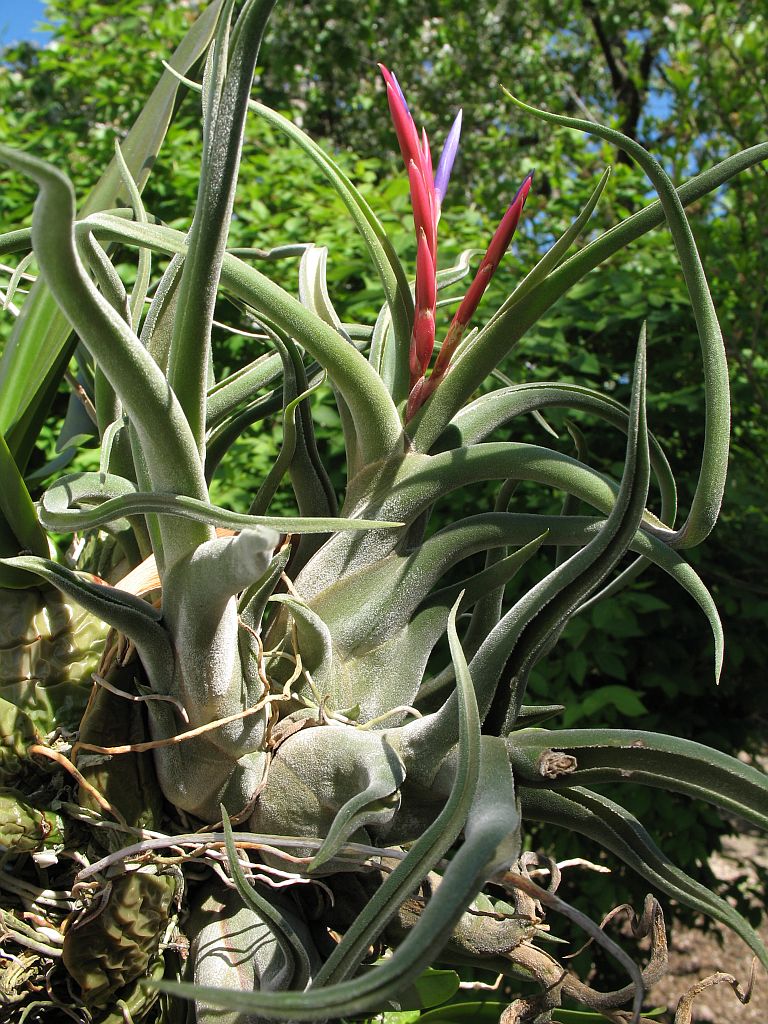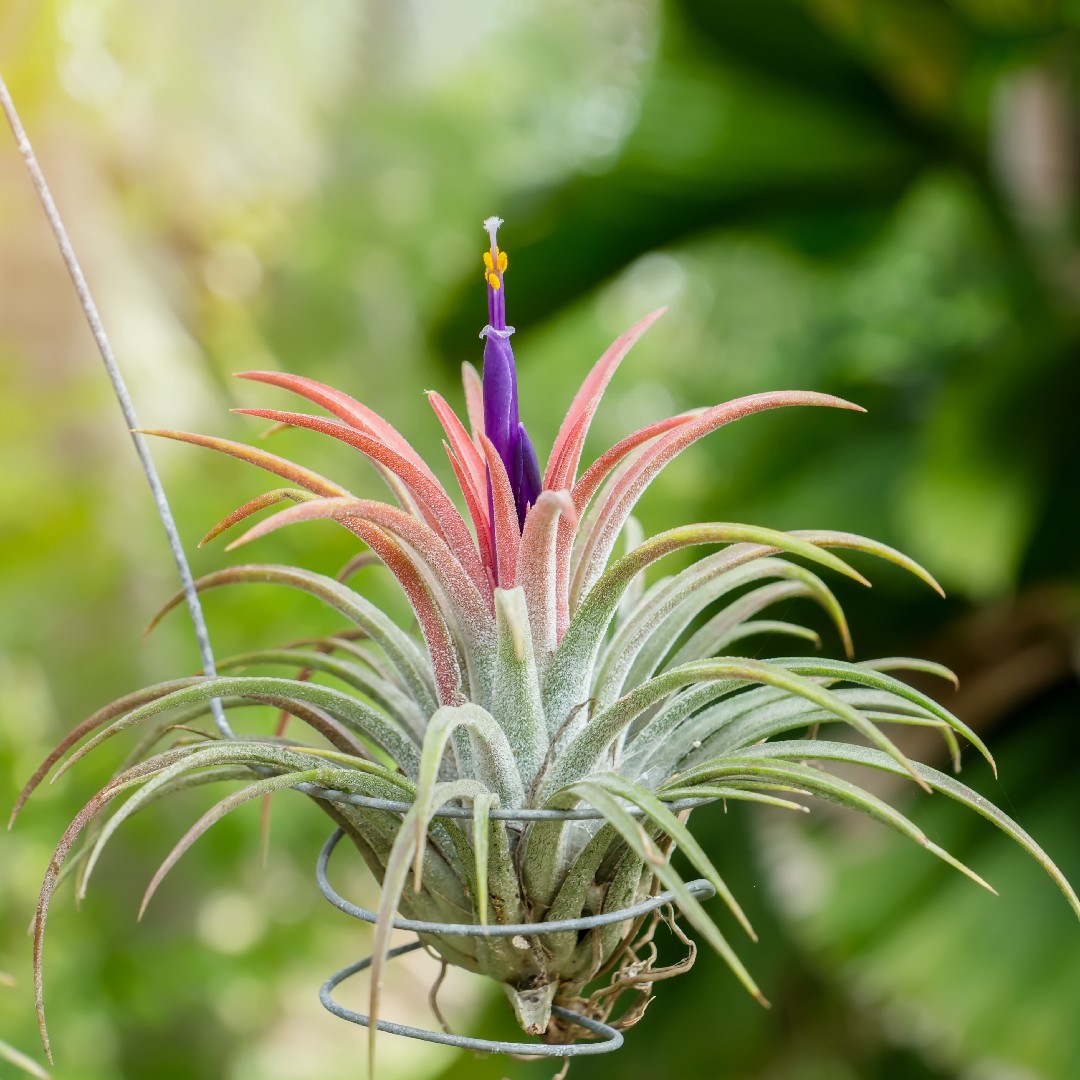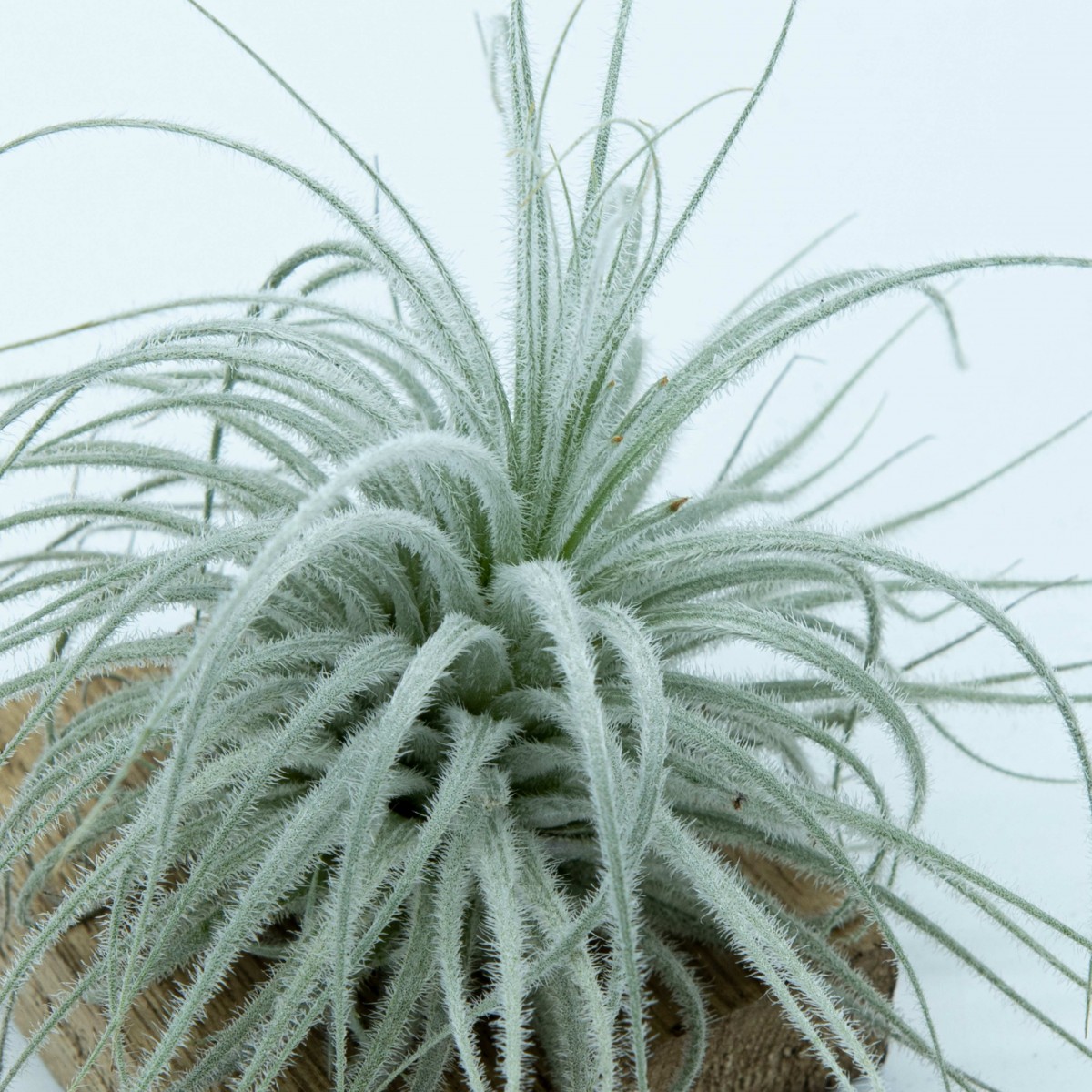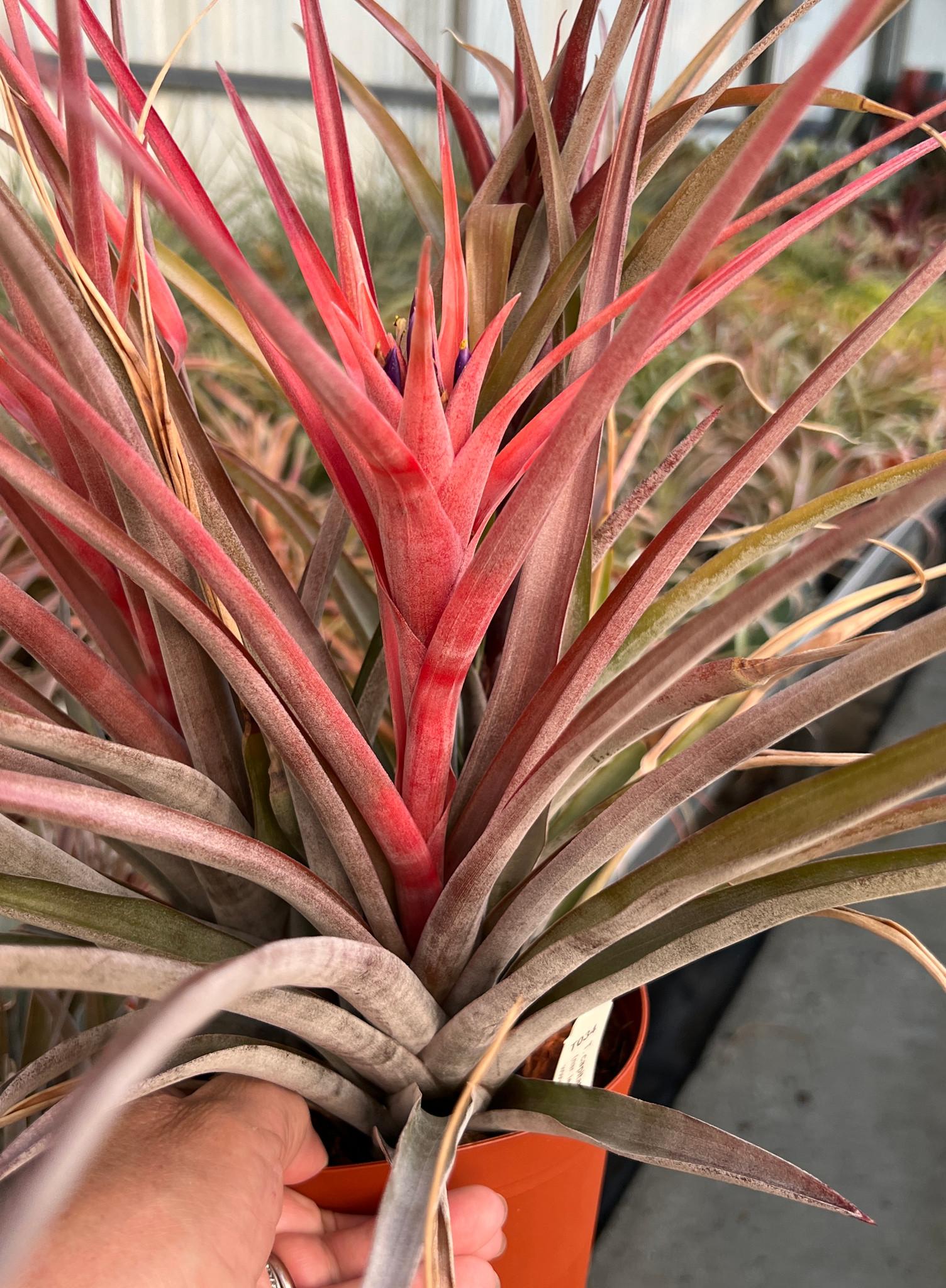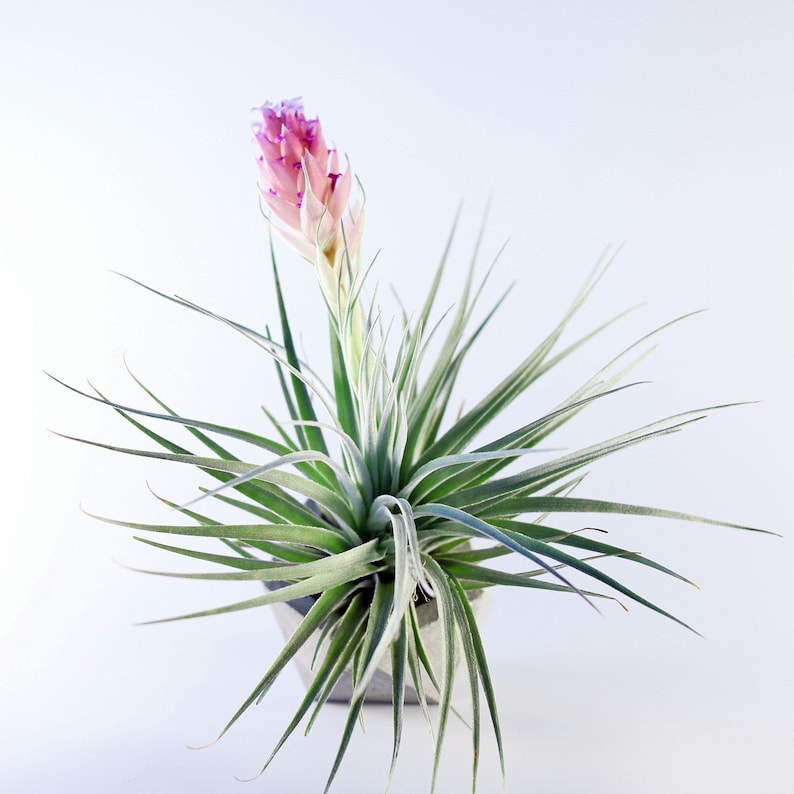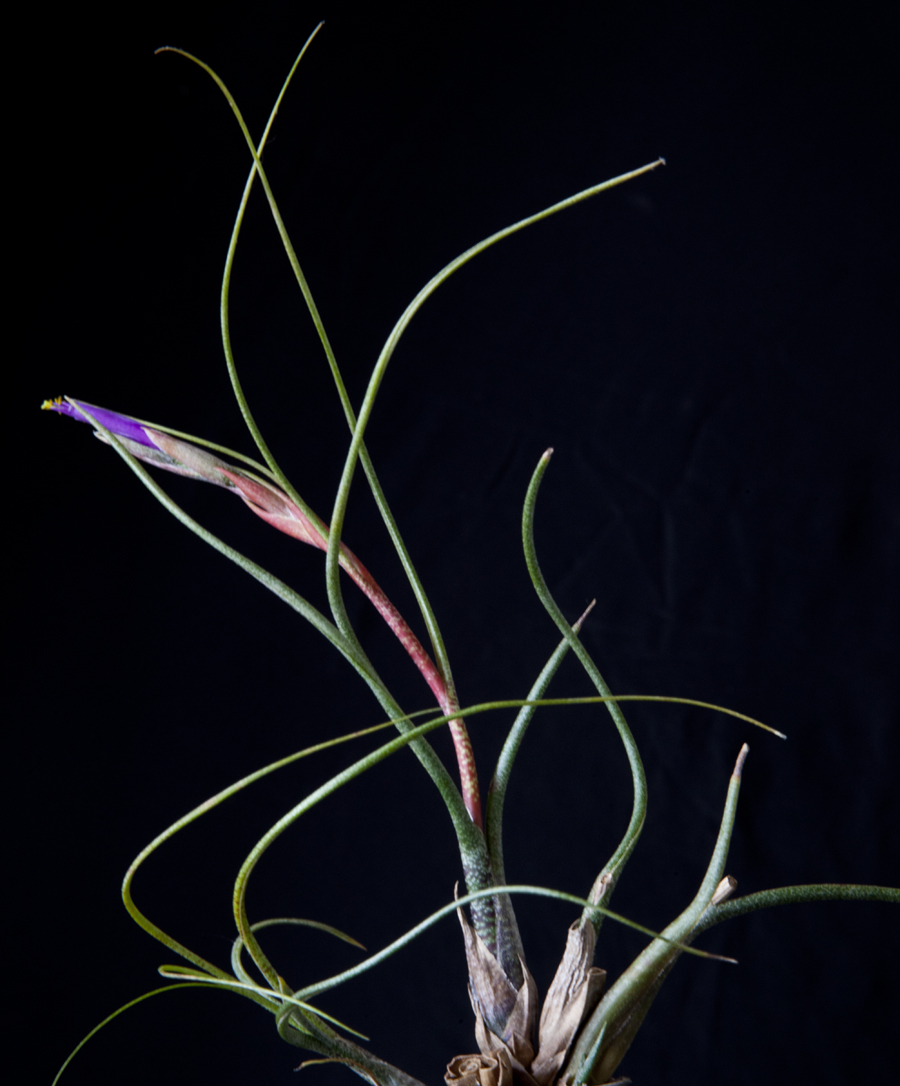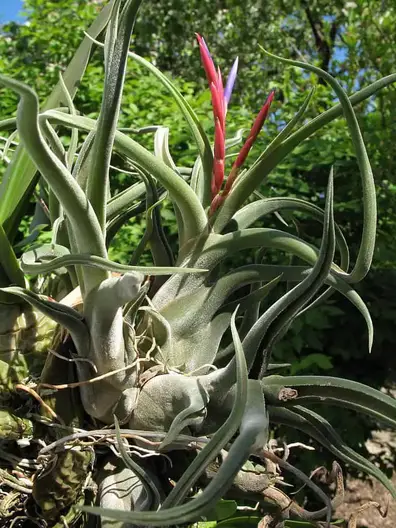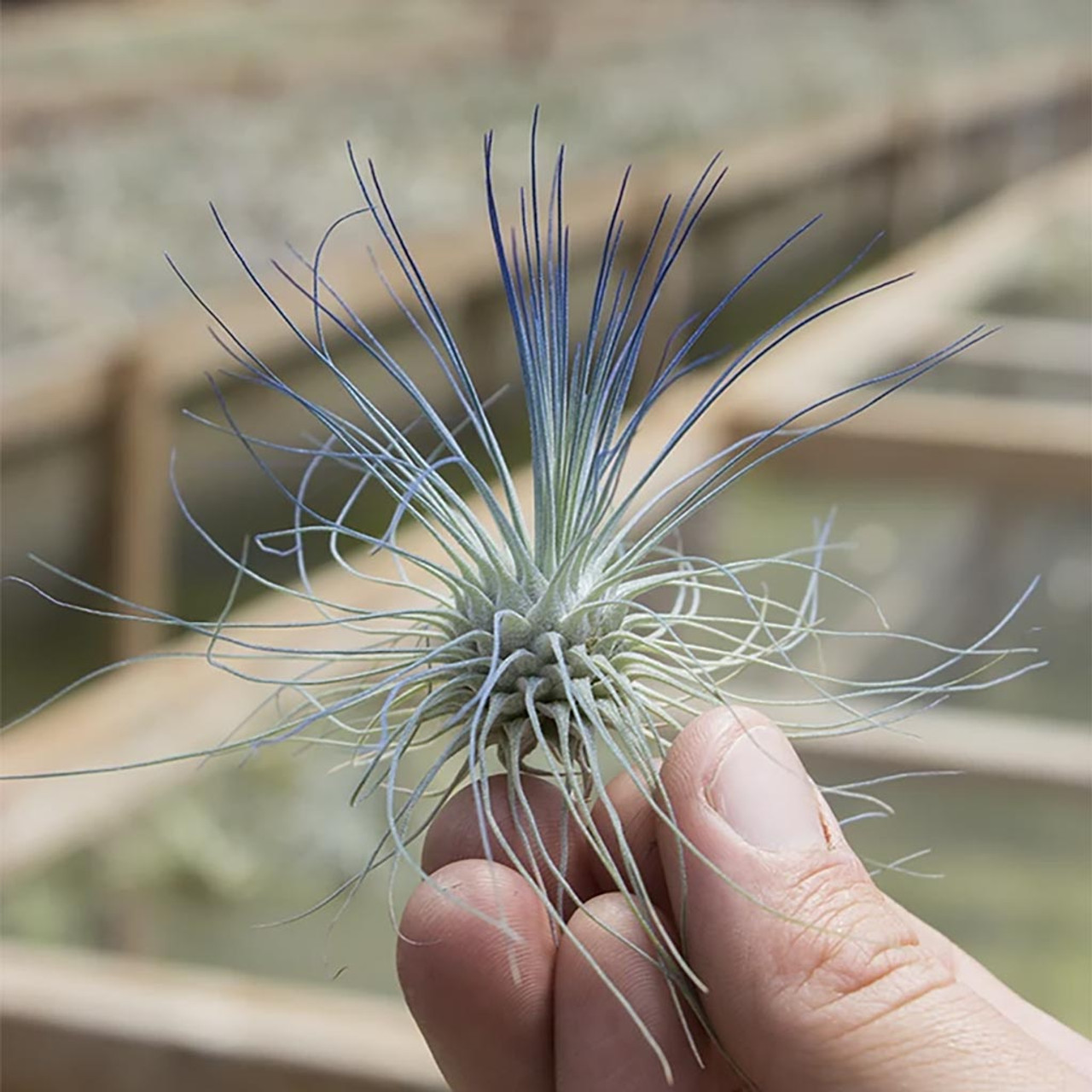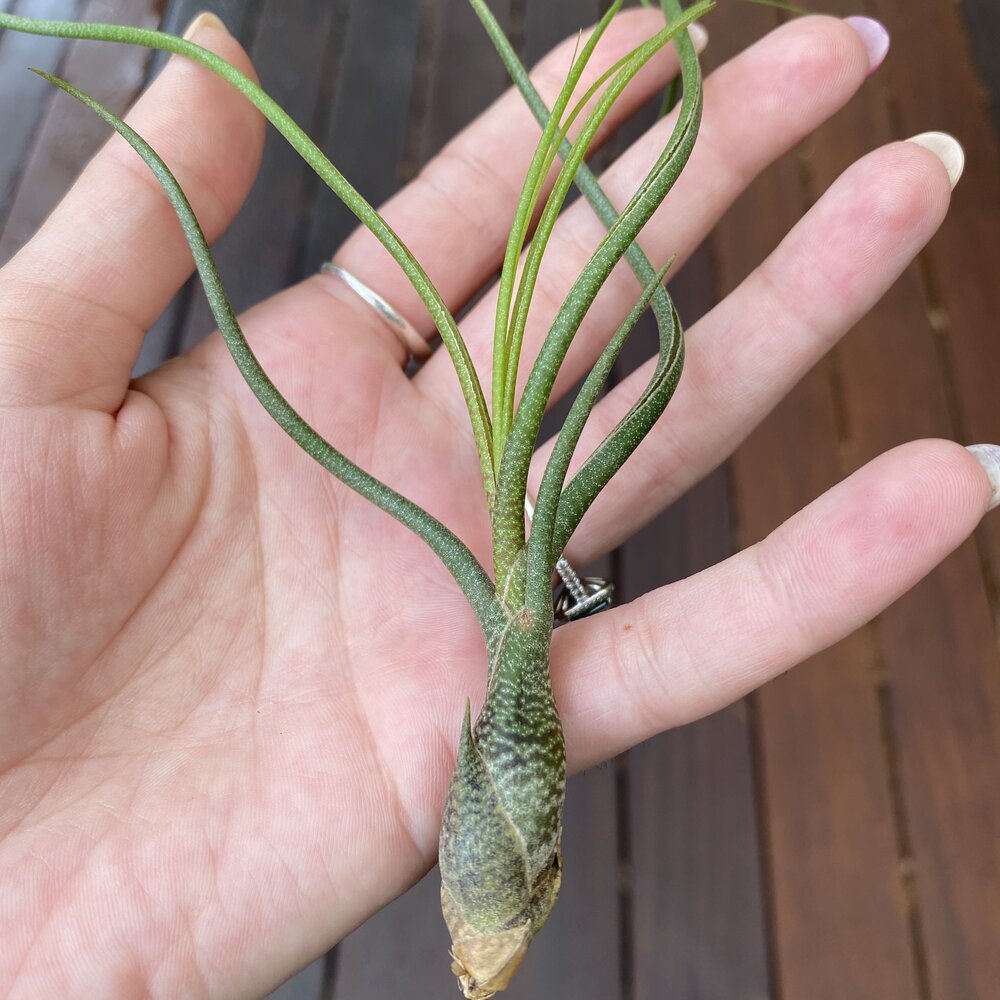Even though thу most air plants are typically simple to maintain and care for, some still need more attention than others. The top 11 popular air plants for beginners and time-pressed people who don’t have much free time are listed in this article (easiest care air plants for office spaces).
The accessibility and ease of maintenance of air plants determine which ones are the best for beginners or busy people. The best air plants in this category are those that can withstand office environments and beginner mistakes.
Best air plants for beginners with minimal care (tillandsia species)
-
Tillandsia harrisii
-
Tillandsia caput-medusae
-
Tillandsia ionantha
-
Tillandsia fuchsii
-
Tillandsia tectorum
-
Tillandsia streptophylla
-
Tillandsia aeranthos
-
Tillandsia capitata
-
Tillandsia stricta
-
Tillandsia butzii
-
Tillandsia tenuifolia
-
Tillandsia xerographica
1 Tillandsia harrisii
The air plant Tillandsia harrisii has rosette-shaped leaves that are soft and fuzzy and have a silvery color. You shouldn’t have any trouble locating them for sale because they are widely accessible. This fuzzy air plant is a member of the xeric group, which originates from hotter regions of the world. This would imply that T. harrisii doesn’t require a lot of watering and can survive if you neglect it occasionally. For newcomers and busy people, that is excellent news. Your plant needs frequent waterings if you notice that it’s less fuzzy and seems dry.
Additionally, because T. harrisii prefers bright light, you can place it close to a window or windowsill where it will receive indirect light the majority of the day and bright, unfiltered light in the morning and afternoon. Use fluorescent lights similar to these in an office or during the winter (that applies for all air plants).
2 Tillandsia caput-medusae
The bulbous air plant Tillandsia caput-medusae has green, curly leaves. It is well-known for its intriguing snake-shaped leaves; it is also referred to as an octopus plant.
This air plant’s leaves start to turn purple when given enough light.
It’s wonderful to know that Tillandsia caput-medusae doesn’t require a lot of watering.
It is very well adapted to dry environments. Instead of soaking or submerging the plant, stick to misting it.
During the summer, mist it three times weekly, twice in the spring and fall, and once a week in the winter.
In the summer, you can also give the plant a weekly 10-minute soak in water. To avoid the plant rotting, always be sure to shake off any extra water.
You can put Tillandsia caput-medusae somewhere with unfiltered morning and afternoon light and then filtered light for the remainder of the day because it prefers bright light.
Its lighting requirements should be met by bright, filtered light in general.
3 Tillandsia ionantha

The majority of t. ionantha species have small, fuzzy leaves. Some, like t. ionantha rubra and fuego, exhibit much more reddish coloring.
Tillandsia ionantha appreciates lots of light that is both filtered and indirect. Place it close to a window, but make sure there is plenty of ventilation.
These plants enjoy a good misting as well, but not prolonged watering. Once a week in the summer, you can soak the plant in water for 10 minutes and shake off the excess.
You could also limit yourself to misting it 2-4 times per week. Only mist the plant once or twice a week during the colder months of the year.
4 Tillandsia fuchsii
Tillandsia fuchsii is a tuft-like thin and grassy air plant that is cute and is rather easy to care for. It is also common and you can easily find it for sale.
It’s medium in size and has beautiful dense silvery leaves.
Tillandsia fuchsii loves bright but indirect light, so you can place it somewhere bright without direct sun.
You will need to soak it 1-2 times a week in summer, and once a week during colder months of the year.
If the plant’s tips are brown or dried out, you should mist it. On hot summer days, you can mist the plant in between waterings.
However, if you are busy, stick to misting the plant 2-3 times per week in the spring, fall, and winter and 4-5 times per week in the summer.
Your tillandsia fuchsii can be displayed either alone or with other heat-loving other plants like cacti (can attach on them).
The plant has a tall, pink bloom.
5 Tillandsia tectorum
A cute, white, fuzzy air plant with great drought tolerance is Tillandsia tectorum.
Its leaves have numerous trichomes for absorb water, which accounts for their extremely fuzzy appearance.
Tillandsia tectorum requires little maintenance because it grows slowly and can withstand drought.
It doesn’t need to be deeply watered; 3-5 times per week in the summer and 2-3 times per week in the spring, fall, and winter will do.
Bright, filtered light is ideal for Tillandsia tectorum. You can expose it to direct sunlight in the winter.
Its pink flower with purple bracts is also very lovely.
If you have tillandsia tectorum, keep it away from extremely hot or dry air and dry the plant between waterings.
6 Tillandsia streptophylla
The Tillandsia streptophylla is a fantastic plant for beginners or those who are frequently busy.
Despite being larger than many other air plants, this one is relatively simple to maintain.
With lots of light and while blooming, Tillandsia streptophylla takes on a pinkish tint that makes it very attractive. It has pink and purple blooms.
When the plant is properly hydrated, the leaves of Tillandsia streptophylla become straight rather than curly. You can make a determination about how much water your plant needs based on that.
Provide this plant lots of bright indirect light (it is even fine with 1-2 hours of direct sunlight a day).
Tillandsia streptophylla is bulbous, so it’s better to mist the plant instead of soaking it.
Mist 3-4 times a week during warmer months, and 1-2 times a week in winter.
7 Tillandsia aeranthos
As a very hardy air plant, Tillandsia aeranthos is excellent for beginners. It has large, rigid, green and silvery leaves and is cone-shaped. It is of medium size.
This air plant only needs to be dipped for 10 to 15 minutes once a week in the summer and once a week in the winter. It should be sufficient to simply mist the plant during the winter. Because Tillandsia aeranthos dislikes being wet, be sure to dry it thoroughly and avoid overwatering.
Bright but filtered light is best in the summer.
You can put it indoors or even outside for full sun during the winter.
If it doesn’t get any colder than 23 F (-5 Celsius), Tillandsia aeranthos is hardy enough to withstand, so you can leave it outside.
Tillandsia aeranthos is perfect for beginners and busy homes or offices because it requires little maintenance.
It will quickly produce lovely pink-purple flowers when it is fully grown.
8 Tillandsia capitata
Another excellent air plant for beginners or those who lead busy lives or work in offices is Tillandsia capitata.
This air plant has broad, supple green leaves and is fairly large. They are also very accessible and widely distributed.
Make sure to water Tillandsia capitata as needed because they enjoy good watering.
Dip or soak for 15 minutes a few times a week in the summer, and mist heavily 1-2 times a week in the winter.
Make sure to provide sufficient air exchange so that it can dry.
This air plant enjoys bright light as well, but avoid direct sunlight as the leaves can burn easily.
Once it drops below 40 F (5 C), bring it inside because they don’t handle cold temperatures well.
9 Tillandsia stricta
The hardy, low-maintenance Tillandsia stricta is a good air plant for beginners.
When fully grown, they have lovely, dense green leaves and produce excellent blooms.
Their bloom is a stunning shade of pink. Water well, especially in hot weather, as Tillandsia stricta loves it.
Swim for 15 minutes or soak for 30 minutes once or twice per week in the summer and once per week in the winter.
Make sure the air plant dries completely after watering because it enjoys good air circulation.
Light that is bright but indirect is ideal. Keep inside during colder weather because it does not do well in low temperatures.
When there is little sunlight during the winter, use fluorescent plant lights.
10 Tillandsia butzii
A unique and popular air plant that is excellent for beginners is Tillandsia butzii. It has interesting thin wavy leaves and is quite large (8–10′′), with a bulbous base.
Although Tillandsia butzii is fairly hardy, once it drops below 40 degrees Fahrenheit (5 degrees Celsius), bring it inside.
In the summer, soak them in water for 15-20 minutes twice a week, and once a week in the winter.
They enjoy good watering.
In the winter, you can instead mist heavily once per week.
Tillandsia butzii also grows rather fast, generally faster than most other air plants.
Their blooms are beautiful red in color.
They produce pups, and if you don’t separate them, they will form a beautiful clump.
11 Tillandsia tenuifolia
Another relatively easy-to-care-for air plant is Tillandsia tenuifolia. It has lovely rigid green leaves. Its leaves start curling slightly as they get older.
The Tillandsia tenuifolia has stunning blooms (pink and flower).
This air plant can survive with a slight lack of light, but it prefers bright, filtered light. This makes this plant appropriate for use in offices (however bright light is still required).
Water by dunking for 10-15 minutes 1-2 times/week in summer, and once a week in winter.
Make sure it dries fully to prevent rot, as the base shape can catch extra water.
12 Tillandsia xerographica
Xeros stand out from other air plants in terms of aesthetic appeal.
As they grow, their lovely silver leaves curl and spiral around one another.
This produces a striking, nearly spherical plant that will provide you with stunning living décor that is simple to maintain because of its slow growth habits.
You may need to water (and mist) more or less often, depending on how humid your home is.
Your Xero will let you know if it is thirsty: when it needs more water, the leaves will curl tightly.
If they start to wrinkle, your air plant is parched!
If your Xero’s leaves are very straight you could be watering it too much, which could cause problems like rot.
Just follow the cues that your plant gives you and you’ll find a healthy level of water for your leafy friend.
You can buy air plants here.
FAQ: How to Grow Air Plants good
Are air plants easy to keep alive?
They’re almost zero-maintenance, but a little care will help them live their best lives. When it comes to indoor plant care, air plants (Tillandsia) are supposed to be some of the easiest.
Where do you put air plants?
Air plants do best with at least a few hours of bright, indirect sun daily. Placement within 1 to 3 feet of an east- or west-facing window, or within a foot or two of an artificial light source is ideal. If you keep them well watered, they can have hotter, more direct sun and longer exposure. Avoid dimly lit locations.
Can you just mist air plants?
Misting is simple, just take a spray bottle or a hose attachment on the “mist” setting and lightly mist your plants. When misting, make sure that the entire plant is moistened. As stated before, this is not the best watering method to use if this is their only source of water.
What is the lifespan of an air plant?
Tillandsias, commonly known as air plants, are perennial plants. This means that they typically live for more than two years (source), with their lifespan ranging between 2 to 5 years. However, their lifespan varies depending on the type of air plant and also the growing conditions.
Do you soak air plants upside down?
It is very important to lay your air plants out on a dish towel on their side or upside down to let them dry completely. This is especially important for the larger species like Xerographica, Streptophylla, and Sparkler. They should be fully dry to the touch within 2 hours after their bath.
How often should I soak my air plant?
How often do I water my air plants? Your plants should be watered once per week, and 2-3 times is recommended for optimal care. A longer, 2-hour soak is recommended every 2-3 weeks. If you are in a drier, hotter climate, more frequent watering or misting will be needed.
Do air plants get bigger?
Do Air Plants Grow Bigger? If your air plant is a pup (baby air plant) then it will grow to full size depending on its species. As stated above, air plants range in size from two inches to seven feet so research your variety to find out more about how big it will grow.
What is the best way to keep air plants alive on direct sunlight?
Below are 5 simple rules of thumb to follow when caring for Tillandsia:
- 1) Water your Airplant Regularly (general rule). You will need to regularly water your airplant.
- 2) Give your Airplant Light.
- 3) Let Your Airplant Have Some Air.
- 4) Keep Your Airplant in a Nice Temperature.
- 5) Don’t do this to your Airplant.
What do air plants need?
While they are called “air plants” as they do not require soil and take their nutrients from the air, they still need water, nutrients, and light to survive. Air Plants are technically epiphytes, meaning that they grow in nature on another tree, host, or object.
What do you do with new air plants?
Here’s what we recommend as a starting point:
- Every one to two weeks, soak your air plant in room temperature tap water (or rain/pond water if you can find it) for 5-10 minutes.
- After soaking gently shake excess water from your plant. …
- From the time soaking ends, the plant should be able to dry fully within 3 hours.
Can I put my air plant on rocks?
In fact the majority of air plants should NOT be planted in soil. You can easily layer moss, sand, or rock to create variation and texture in your terrarium.
You don’t want your air plants sitting against any moisture in their terrariums or holders, so make sure whatever base you use is completely dry.
Do air plants have babies?
On average, air plants will create 1 to 3 pups after the blooming process. Some varieties can product many, many more. Separating Pups from the parent plant: You can gently remove offsets from the mother plant when they grow to be about 1/3 the size of the mother.
Can you put air plants in jars?
Mason jars are yet another way you can display your air plants. You should although make sure that you do not completely cover the pot. Covered chalices interfere with free air circulation, which may result in the nutrient deprivation of your crop.
Why are my air plants rotting?
A rotting air plant is generally a sign of excess water or humidity. Air plants grow in dry environments, and while they need to be watered deeply and prefer air humidity to sit around 65%, they don’t like to remain wet. You should be watering your air plant only every week or two, depending on the species.



